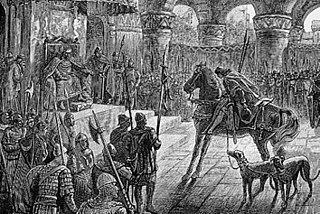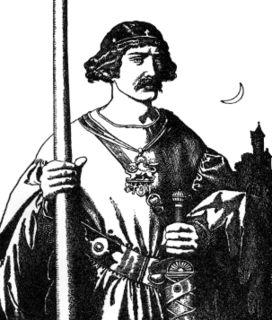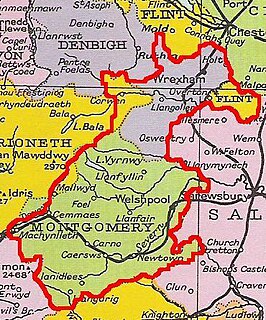Related Research Articles

Excalibur is the legendary sword of King Arthur, sometimes also attributed with magical powers or associated with the rightful sovereignty of Britain. It was associated with the Arthurian legend very early on. Excalibur and the Sword in the Stone are in some versions said to be different, though in most incarnations they are the same. In Welsh, it is called Caledfwlch; in Cornish, Calesvol ; in Breton, Kaledvoulc'h; and in Latin, Caliburnus. Several similar swords and other weapons also appear in this and other legends.

Mabon ap Modron is a prominent figure from Welsh literature and mythology, the son of Modron and a member of Arthur's war band. Both he and his mother were likely deities in origin, descending from a divine mother–son pair. His name is related to the Romano-British god Maponos, whose name means "Great Son"; Modron, in turn, is likely related to the Gaulish goddess Dea Matrona. He is often equated with the Demetian hero Pryderi fab Pwyll, and may be associated with the minor Arthurian character Mabon ab Mellt.

The Mabinogion are the earliest prose stories of the literature of Britain. The stories were compiled in Middle Welsh in the 12th–13th centuries from earlier oral traditions. There are two main source manuscripts, created c. 1350–1410, as well as a few earlier fragments. The title covers a collection of eleven prose stories of widely different types, offering drama, philosophy, romance, tragedy, fantasy and humour, and created by various narrators over time. There is a classic hero quest, "Culhwch and Olwen"; a historic legend in "Lludd and Llefelys," complete with glimpses of a far off age; and other tales portray a very different King Arthur from the later popular versions. The highly sophisticated complexity of the Four Branches of the Mabinogi defies categorisation. The stories are so diverse that it has been argued that they are not even a true collection.

Mordred or Modred is a figure who is variously portrayed in the British tradition. The earliest known mention of a possibly historical Medraut is in the Welsh chronicle Annales Cambriae, wherein he and Arthur are ambiguously associated with the Battle of Camlann in a brief entry for the year 537. His figure seemed to have been regarded positively in the early Welsh tradition and may have been related to that of Arthur's son.
Owain mab Urien was the son of Urien, king of Rheged c. 590, and fought with his father against the Angles of Bernicia. The historical figure of Owain became incorporated into the Arthurian cycle of legends where he is also known as Ywain, Yvain, Ewain or Uwain. In his legendary guise he is the main character in Chrétien de Troyes's Yvain, the Knight of the Lion and the Welsh Romance Owain, or the Lady of the Fountain, which corresponds to Chrétien's poem.
Morfran is a figure in Welsh mythology. Usually portrayed as a warrior under King Arthur, he is noted for the darkness of his skin and his hideousness. He appears in the narratives about the bard Taliesin and in the Welsh Triads, where he is often contrasted with the angelically handsome Sanddef.
Rhun ap Maelgwn Gwynedd, also known as Rhun Hir ap Maelgwn Gwynedd, sometimes spelt as 'Rhûn', was King of Gwynedd. He came to the throne on the death of his father, King Maelgwn Gwynedd. There are no historical records of his reign in this early age. A story preserved in both the Venedotian Code and an elegy by Taliesin says that he waged a war against Rhydderch Hael of Alt Clut and the kings of Gododdin or Manaw Gododdin. The small scattered settlement of Caerhun in the Conwy valley is said to be named for him, though without strong authority. Rhun also appears in several medieval literary stories, as well as in the Welsh Triads. His wife was Perwyr ferch Rhûn "Ryfeddfawr" and their son was Beli ap Rhun "Hîr".
Cador was a legendary Duke of Cornwall, known chiefly through Geoffrey of Monmouth's pseudohistorical Historia Regum Britanniae and previous manuscript sources such as the Life of Carantoc.
Octa was an Anglo-Saxon King of Kent during the 6th century. Sources disagree on his relationship to the other kings in his line; he may have been the son of Hengist or Oisc, and may have been the father of Oisc or Eormenric. The dates of his reign are unclear, but he may have ruled from 512 to 534 or from 516 to 540. Despite his shadowy recorded history Octa made an impact on the Britons, who describe his deeds in several sources.

Sir Ywain, also known as Yvain, Owain, Uwain(e), Ewaine, Iwain, Iwein, Ivain, Ivan, etc., is a Knight of the Round Table in Arthurian legend, wherein he is often the son of King Urien of Gorre and the sorceress Morgan le Fay. The historical Owain mab Urien, on whom the literary character is based, was the king of Rheged in Great Britain during the late 6th century.

King Hoel, also known as Sir Howel and Saint Hywel, was a late 5th- and early 6th-century member of the ruling dynasty of Cornouaille. He may have ruled Cornouaille jointly after the restoration of his father, Budic II of Brittany, but he seems to have predeceased his father and left his young son, Tewdwr, as Budic's heir.

Madog ap Maredudd was the last prince of the entire Kingdom of Powys, Wales and for a time held the Fitzalan Lordship of Oswestry.

The Dream of Rhonabwy is a Middle Welsh prose tale. Set during the reign of Madog ap Maredudd, prince of Powys, its composition is typically dated to somewhere between the late 12th through the late 14th century. It survives in only one manuscript, the Red Book of Hergest, and has been associated with the Mabinogion since its publication by Lady Charlotte Guest in the 19th century. A diplomatic version of the text is published by the University of Wales Press as Breuddwyt Ronabwy, edited by Grafton Melville Richards, first published in 1948. The bulk of the narrative describes a dream vision experienced by its central character, Rhonabwy, a retainer of Madog, in which he visits the time of King Arthur.
Menw, son of Three-Cries, is a hero and shapeshifter in early Welsh literature, an "Enchanted Knight" of King Arthur at his court at Celliwig. He appears most prominently in the early Arthurian tale Culhwch and Olwen, in which he is handpicked among Arthur's warriors to accompany Culhwch on his quest to win Olwen. An "Enchanter Knight" of Arthur's court, he learned one of the Three Enchantments from Uther Pendragon. He is ascribed a son named Anynnawg.
Rhuawn Bebyr is the son of Deorthach Wledig in early Arthurian literature and mythology. He appears as a member of Arthur's retinue in two medieval tales, "How Culwch won Olwen" and "The Dream of Rhonabwy". In the latter, he is described as a "young lad with yellowish-red hair, without a beard or a moustache, and the look of a nobleman about him".

Edern ap Nudd was a knight of the Round Table in Arthur's court in early Arthurian tradition. As the son of Nudd, he is the brother of Gwyn, Creiddylad, and Owain ap Nudd. In French romances, he is sometimes made the king of a separate realm. As St Edern, he has two churches dedicated to him in Wales.
Gwrhyr Gwalstawd Ieithoedd; "Gwrhyr, Interpreter of Languages" is a hero and shapeshifter of early Welsh literature and mythology and a warrior of King Arthur's court at Celliwig. He appears most prominently in the early Arthurian tale Culhwch and Olwen, in which he is handpicked among Arthur's knights to accompany Culhwch on his quest to win Olwen.
Goreu fab Custennin is a hero of Welsh and early Arthurian mythology, the son of Custennin, and cousin to Arthur, Culhwch and Saint Illtud through their grandfather Amlawdd Wledig. He is a significant character in the Middle Welsh Arthurian tale Culhwch and Olwen, and also appears in a number of other medieval texts. His name may be derived from Gorneu; "of Cornwall."
According to Welsh tradition, Afaon fab Taliesin was the son of the bard Taliesin and a member of King Arthur's retinue. He appears both in the Welsh Triads and in the medieval Arthurian tale Breuddwyd Rhonabwy.
Rhun is a Welsh Masculine given name meaning "Great, Mighty". Variants of the name are; Rhûn, Rhyn and Rhŷn.